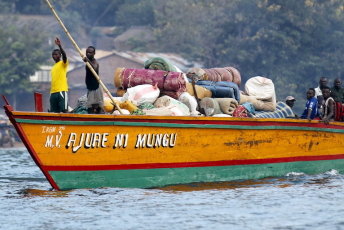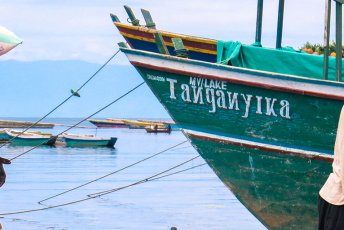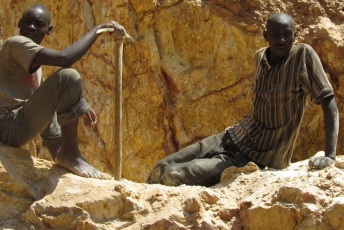The Mining Indaba is an annual event that provides a platform for mining companies, experts, policymakers and governments from the African continent to discuss opportunities, challenges and prospects. Addressing illegal gold mining was one of the priorities at the 2019 Mining Indaba.
For organised crime groups, illegal mining is a lucrative enterprise. In South Africa, it is often linked to human smuggling and trafficking; illegal weapons and explosives; tax evasion; money laundering; corruption and gang-related activities – as identified by the Directorate for Priority Crime Investigation in a 2017 parliamentary briefing .
At the indaba, South African Minister of Mineral Resources Gwede Mantashe and Ghana’s President Nana Akkufo-Ado both deplored the threat of illegal mining in their respective countries, but differed on how to address the problem. While Mantashe preferred legalising illegal mining through the issue of licenses, Akkufo-Ado advocated placing a ban on artisanal and small-scale mining for a limited period.
In his speech, Akkufo-Ado noted how a two-year ban on unlicensed mining had previously helped to curb illegal mining, whereby ‘heavy polluted rivers showed signs of being restored to health’. In addition to the ban, small-scale miners were being trained in responsible mining, while alternative livelihood resources were provided to others.
In 2017, the government of Ghana commissioned a 400-member contingent – codenamed Operation Vanguard – to combat illegal mining and introduced a two-year ban in the most-affected regions of the country. By the time the ban was lifted in December 2018, around 1687 illegal miners had been arrested.
However, criticisms levelled at the government included an excessively heavy-handed approach towards illegal and small-scale miners alike. Soldiers were reportedly involved in extortion. Most of those arrested were illegal miners and the actors who bought the gold from them, leaving other key players in the criminal network – such as those who launder or export the illegal gold – untouched and free to return to their operations once the ban had been lifted.
In South Africa, illegal mining costs the economy around R21 billion annually. Other threats of illegal mining include temporary closures of commercial mines, illegal miners who are trapped underground and most pertinently, the death of or injuries to illegal miners. The increasing prevalence of violence between competing, heavily armed syndicates is another area of concern.
While the government approach, in the long term, is to focus on legalising the status of illegal miners, it has also put in place certain measures to address the issue on the ground. This includes establishing a multi-agency National Coordination and Strategic Management Team (NCSMT) in June 2010. In his speech at the indaba, Mantashe alluded to the increased number of permit applications by small-scale miners as a sign of the success of the NCSMT. Despite the measures taken by the government, though, illegal mining – especially of gold – is a growing threat.
Legalising illegal mining is often a preferred option, as it promotes the goals of the action plan of the African Mining Vision, which was adopted by African heads of state in 2009 –namely to create a ‘mining sector that harnesses the potential of artisanal and small scale mining to advance integrated and sustainable rural socio-economic development’. However, legalisation comes with its own challenges.
Although the majority of illegal miners are propelled into the field by socio-economic circumstances, there is also a need to understand the criminal syndicates involved in the sector. The latter often use any means necessary to achieve their goal of extracting as much gold as possible.
A former section commander in the Explosives Unit of the South African Police Service, who spoke to ENACT under condition of anonymity, explained that ‘the majority of these guys [illegal miners] are criminals and they would not think twice to shoot police and escape the rule of law’. Often, when police attempt to arrest illegal miners, they are met with heavy gunfire and explosives placed at strategic points in the mine to evade arrest.
In this instance, illegal mining can be viewed as a criminal activity motivated by profit, whereby the actors would do anything to escape punishment. Thus, legalising illegal mining would yield few results in dealing with the problem. As the commander emphasised, this would be tantamount to ‘legitimising crime at the cost of the rule of law’.
The Mineral and Petroleum Resources Development Act (20 of 2002) aims to regulate artisanal mining, but has had limited success in addressing illegal mining. The fact that illegal mining is not clearly defined in the legislation is a critical gap in dealing with the issue effectively.
The Directorate for Priority Crime Investigation notes ‘legislation gaps in addressing transportation/possession of PMDs [precious metals and diamonds] in transit areas’. In such instances, illegal miners who are caught can only be charged with trespassing and receive fines as low as R50 (US$3).
However, the NCSMT task team has been assessing legislation provisions to allow illegal miners and syndicate members to be prosecuted on more serious charges under the Prevention of Organised Crime Act. Furthermore, illegal mining is connected to other forms of organised crime, and addressing the issue requires targeting the syndicate members. Most efforts target the illegal miners, who are often easily replaced by syndicates. Due to the large number of unemployed individuals with (or without) mining experience, illegal miners can easily be sourced from this pool of recruits.
Once the illegal miners obtain the gold from the mine, it is sold to buyers, often residing in the surrounding area, who in turn smelt the gold ‘mixing stolen high-grade material with low-grade material to conceal its nature and source’.
Ciaran Ryan, a mining expert, suggests that a way to deal with these buyers is to introduce them into the formal economy by ‘making them licensed gold dealers’. In this way, they would be liable to pay tax on the gold and precious metals.
Actors at higher levels in the syndicates are more difficult to apprehend. Therefore, a collaborative effort and strengthening of inter-agency support – such as between law enforcement, the mining industry, Department of Mineral Resources and immigration – is required to target them.
Illegal mining is a complex phenomenon, and a multi-faceted approach is required to stem the problem. Since the practice affects a broad range of actors, including from government, the mining industry and law enforcement, no agency or sector can address the issue on its own.
A strategy that addresses all the issues identified will require commitment and practical action from the various stakeholders involved. An ideal place to launch the strategy Would be at the Mining Indaba, where various stakeholders discuss potential and current ways to develop a thriving mining sector.
Richard Chelin, Researcher and Naomi Tite, Programme Administrator, ENACT project, ISS.







